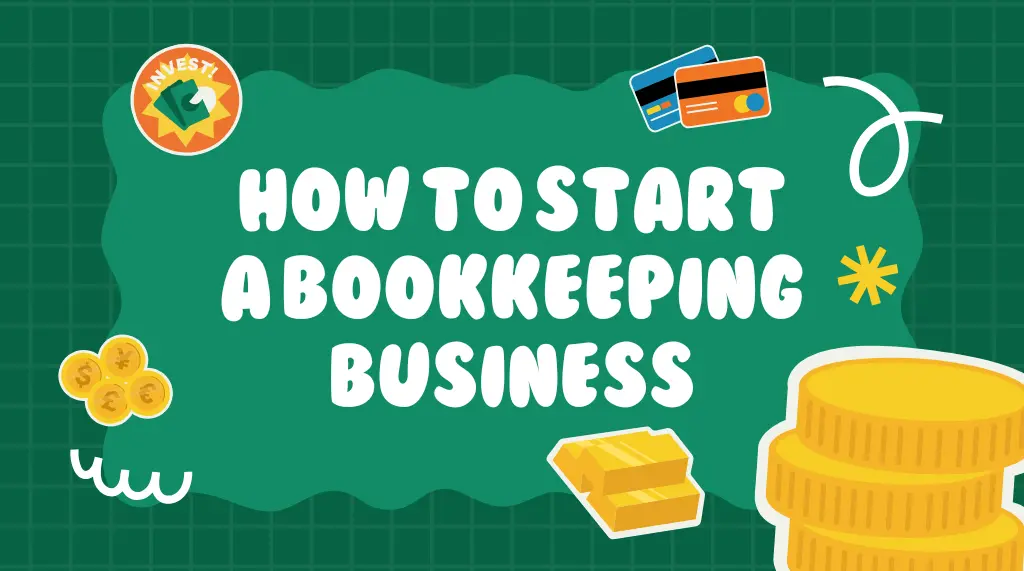Are you ready to start your own bookkeeping business? With the right plan, anyone—whether fresh from another job or with limited experience—can set up a bookkeeping operation from scratch. Here’s a guide to starting strong and fast-tracking your way to success in the bookkeeping industry.
Setting the Stage: Why Bookkeeping and How to Get Started
The best part about launching a bookkeeping business is that you don’t need a financial background or even a degree to get started. Many successful bookkeepers have learned on the go and achieved remarkable growth. In fact, bookkeeping can generate substantial income quickly if managed well. For instance, by consistently offering monthly services, bookkeepers can build a client base that provides reliable revenue—some even reaching monthly earnings of $30,000 or more.
Step 1: Secure Your Financial Safety Net
It’s important to stay financially stable while building your business, especially in the beginning. Keep your current job for a while and build a savings buffer—ideally six months’ worth of expenses—before diving in full-time. With this security, you’ll be better equipped to handle unexpected challenges. Having a plan for when to pivot back to a previous career if your business doesn’t grow as expected is a wise safety measure.
Step 2: Establish Your Bookkeeping Business Legally
To start, you’ll need to get your business’s basic legal structure in place. This means setting up a business checking account, registering as an LLC, and obtaining an Employer Identification Number (EIN). These foundational steps legitimize your business and make it easier to handle finances, taxes, and client payments. Although the process can seem daunting, there are countless online resources that simplify business registration, many of which can walk you through it step by step.
Step 3: Master QuickBooks and Bookkeeping Basics
A fundamental skill in bookkeeping is proficiency with QuickBooks, one of the most widely used accounting software options. The great news is you can get started for free and even work toward becoming a QuickBooks Online Certified ProAdvisor. This certification reassures clients that you have the knowledge necessary to handle their finances. Not only does QuickBooks help manage finances accurately, but its certification also boosts your credibility.
Aside from QuickBooks, learning the basics of accounting—like debits, credits, assets, and liabilities—is also useful. Taking an introductory accounting course, which can cost as little as $300 online, will provide you with foundational knowledge that boosts your skill set. Alternatively, there are many online resources to learn essential bookkeeping fundamentals for free.
Step 4: Streamline Your Marketing and Networking Strategy
Once your skills are honed, your next big focus is marketing. In today’s world, a website and strong online presence are key to reaching potential clients. Platforms like Shopify and Squarespace make it easy to create a professional website with ready-made templates. Additionally, setting up a Google My Business profile helps boost visibility in local searches, making your business more accessible to people in need of bookkeeping services. Gathering client reviews on Google My Business can lend instant credibility; even a few positive reviews can make a significant difference in building trust with new clients.
Social Media Marketing: A Step-by-Step Guide
Social media is crucial to finding and connecting with potential clients without the upfront costs of paid advertising. Building a daily routine around social media engagement can help you cultivate a steady following and client base. Here’s a streamlined, four-step approach:
- Create Content Daily: Share insights, tips, and updates to keep your audience engaged. This could be anything from explaining tax tips to bookkeeping basics.
- Find Potential Clients: Engage with local businesses and industry-related profiles.
- Connect on Multiple Platforms: Use LinkedIn, Facebook, Instagram, or any platform where business owners are active.
- Engage Actively: Build relationships by commenting on posts, responding to questions, and messaging your new connections.
Consistency is key here. Just as regular exercise yields physical benefits over time, sticking with a daily social media routine will lead to visible results. Engaging regularly with clients and prospects builds a reliable pipeline of leads.
Step 5: Sales Outreach Made Simple
When you’ve created a following and engaged with potential clients, the next step is reaching out. Sales in bookkeeping can be as simple as sending a direct message to new social media connections. Start by introducing yourself as a bookkeeper and offering assistance with their QuickBooks needs or general bookkeeping services. Networking and direct communication are powerful ways to secure that all-important first client, and they lay the groundwork for lasting client relationships. The more you engage, the more you build credibility and trust, eventually leading to a steady stream of inquiries.
Part 2: Building a Scalable Bookkeeping Business Framework
Once you’ve set up the basics and started to network, it’s time to lay down a sustainable framework for your bookkeeping business. This step is vital to manage client relationships effectively, streamline workflows, and ultimately scale your business without overextending yourself.
Mastering Client Acquisition and Relationship Building
Now that you’ve started to reach out to prospective clients on platforms like Facebook, LinkedIn, and Instagram, you should have a growing network of people who know about your services. This is where relationship-building becomes essential. A successful bookkeeping business doesn’t just rely on landing clients; it’s built on long-term relationships that retain them.
- Engage Regularly: Be consistent in commenting on posts, responding to comments, and liking posts from business owners in your network. By staying active, you keep your name top-of-mind, making it more likely that they’ll reach out when they need bookkeeping services.
- Offer Value in Every Interaction: Sharing valuable tips, resources, or even case studies in your social media feed or through direct messages can demonstrate your expertise without feeling like a hard sell. This approach will also show prospective clients that you’re knowledgeable and trustworthy.
- Follow Up Strategically: Periodically touch base with your contacts without coming across as overly persistent. This can be as simple as a friendly message checking in, or even sharing a useful article that might interest them.
- Referrals and Testimonials: Once you’ve established credibility with initial clients, ask them for referrals. Many small business owners trust word-of-mouth recommendations, so building a solid base of testimonials and referral clients can be a powerful asset.
Essential Tools and Systems to Enhance Productivity
As your client list grows, it’s easy to become overwhelmed without a streamlined system. Investing in the right tools can help you stay organized, efficient, and productive.
- Accounting Software: Tools like Shopify are great for creating seamless e-commerce integrations for clients who run online businesses. Additionally, accounting tools like QuickBooks (if you haven’t started with it yet) will be critical for managing various clients’ financial data securely and effectively.
- Customer Relationship Management (CRM): A CRM platform can be invaluable for tracking client interactions, follow-ups, and deadlines. With a CRM, you’ll have a central place to store important information, reducing the risk of missed communications or deadlines.
- Project Management Software: Using tools like Asana, Trello, or ClickUp can help you organize tasks by client, assign deadlines, and set reminders. This setup helps in keeping your workflow smooth and ensures all steps of the bookkeeping process are properly handled for each client.
- File Sharing and Data Storage: Since bookkeeping often involves sensitive documents, set up secure file-sharing and data storage systems. Platforms like Google Drive or Dropbox for Business offer easy document sharing, while more specialized tools such as Box provide heightened security for sensitive financial documents.
Pricing Your Services and Structuring Payment Plans
When it comes to pricing, transparency and flexibility are critical to growing a sustainable bookkeeping business. Different clients will have unique needs, so it’s beneficial to set up tiered packages that allow clients to choose a plan that best suits their requirements.
- Tiered Service Packages: Start by designing three to four different service packages. A basic package might include monthly bookkeeping, while higher tiers could offer additional services like payroll, financial reporting, and tax preparation. These packages can appeal to different types of businesses, from solo entrepreneurs to small-to-medium enterprises.
- Pricing Transparency: Be clear about pricing. Displaying prices on your website or providing a pricing guide helps manage expectations from the beginning. Many clients appreciate transparency, especially when it comes to financial services.
- Monthly Retainers and Payment Plans: For a stable income stream, consider monthly retainers that include a set number of hours. Payment plans also allow clients flexibility, encouraging them to stay with you longer. Just be sure to establish clear expectations around what’s covered within each plan, to avoid scope creep.
- Discounts for Long-Term Contracts: Offering small discounts for long-term commitments can also be appealing to clients looking for more affordable options, and they benefit you by securing consistent business.
Scaling Your Business with Outsourcing
Once your client load increases, it may be challenging to handle all the work yourself. At this stage, it’s beneficial to consider outsourcing or hiring an assistant. By delegating some of the tasks, you can focus on growing the business and managing client relationships.
- Identify Tasks to Outsource: Start by outsourcing administrative tasks like data entry, email management, or client onboarding. Virtual assistants or freelance bookkeepers can be a cost-effective way to delegate smaller tasks.
- Building a Team of Specialists: As you scale, consider hiring specialists who can manage specific aspects of your bookkeeping services, such as payroll or tax preparation. Building a small team of experts allows you to offer more comprehensive services, which can help attract larger clients.
- Freelancer Platforms: You can find qualified freelancers on platforms like Upwork or Fiverr. Working with freelancers can provide flexibility since you can hire them on an as-needed basis.
- Training and Quality Control: If you do decide to bring on team members, invest in training and quality control to ensure your services maintain a high standard. Create processes and checklists that team members can follow to ensure consistency in the work being delivered.
Leveraging Financial Metrics to Measure Growth
To understand how well your business is performing, you’ll need to track key financial metrics regularly. Analyzing these metrics will help you make better business decisions and plan for growth.
- Revenue Growth: Track your monthly revenue growth to understand how quickly your business is scaling. Comparing this growth rate to your original goals allows you to adjust strategies as needed.
- Client Retention Rate: Monitor how long clients stay with you, as well as why they may leave. Retaining clients for longer periods typically requires less effort than constantly onboarding new ones, and long-term clients contribute to a stable revenue stream.
- Profit Margin: It’s important to understand the difference between revenue and profit. As you start to outsource or hire, your profit margins may shift. Make sure to monitor expenses closely to keep your profit margin healthy.
- Average Revenue per Client: Track how much revenue each client brings in, on average. This metric will help you identify which services are most profitable, allowing you to focus on those in your marketing efforts.
- Client Acquisition Costs: As you invest in advertising or other marketing efforts, measure how much it costs to acquire a new client. Knowing your acquisition cost will help you determine the return on investment (ROI) of each marketing channel.
Monitoring these financial metrics is essential for staying on track with your business goals. By making data-driven decisions, you can adjust strategies and allocate resources effectively as your business grows.
Maximizing the Value of Shopify in Your Bookkeeping Services
For clients with e-commerce stores, becoming proficient in integrating platforms like Shopify can make your bookkeeping services even more valuable. When you offer specialized support for clients using Shopify, you position your business as a versatile solution for online retailers who need help managing the complexities of sales, inventory, and financial reporting. Here’s how Shopify can enhance your services:
- Automated Sales Tracking: By integrating Shopify with QuickBooks, you can automatically import daily sales transactions, making it easier to reconcile accounts without manual data entry.
- Inventory Management: E-commerce clients using Shopify often require inventory tracking to understand product demand and manage costs. Through efficient tracking, you can help clients reduce excess inventory and improve cash flow.
- Financial Insights: By leveraging data from Shopify, you can provide clients with insights on profitable products, customer trends, and seasonal peaks, which can help them plan and allocate resources more effectively.
- Tax and Compliance Support: Since e-commerce transactions span various tax jurisdictions, you can offer guidance on sales tax compliance. Assisting clients with these details solidifies your role as an integral part of their team, setting you apart from other bookkeepers.
Part 3: Marketing Strategies and Future-Proofing Your Bookkeeping Business
Now that you’ve set up your foundation, established strong client relationships, and implemented effective systems, the next stage is to market your bookkeeping business more extensively. Part 3 focuses on strategic marketing tactics, leveraging data to refine your services, and future-proofing your business for sustained growth and relevance.
Expanding Your Online Presence and Brand Visibility
A strong online presence is essential for attracting clients beyond your immediate network. Your website and social media profiles should clearly communicate your services, expertise, and value proposition. Here are ways to enhance your visibility online:
- Optimize Your Website for SEO: Ensure that your website content uses keywords that potential clients might search for, like “bookkeeping for small businesses,” “QuickBooks bookkeeping,” or “e-commerce bookkeeping specialist.” Writing blog posts and case studies that cover common pain points or topics in bookkeeping can also improve SEO and establish authority in your field.
- Develop Valuable Content: By creating blog articles, downloadable resources, or video content, you can showcase your expertise. For example, you might post short videos explaining common financial concepts or write blog posts on “Top 5 Bookkeeping Mistakes Small Businesses Make.” This type of content attracts visitors to your site, establishes you as an expert, and gives potential clients a reason to return.
- Leverage Social Media Ads: Once you’re confident in your target audience, consider using social media advertising on platforms like LinkedIn, Facebook, and Instagram. These ads can promote your services to a broader, targeted audience, helping you connect with potential clients you may not reach organically.
- Google My Business Listing: Create a Google My Business profile if you haven’t already. When potential clients search for local bookkeepers or accounting services, a complete and verified listing increases the likelihood of showing up in local search results, further improving your business’s visibility.
Establishing Authority Through Partnerships and Guest Content
Collaborative partnerships and guest content are effective strategies for increasing your business’s reach and credibility. By positioning yourself alongside other reputable businesses, you gain exposure to new audiences and establish your authority in the bookkeeping field.
- Partnering with Related Businesses: Connect with local banks, business consultants, or financial advisors who may be willing to refer clients to you. Establishing referral agreements with these partners can provide a consistent flow of clients, as they are already trusted advisors to your target market.
- Writing Guest Articles: Reach out to business or finance blogs and websites to see if they accept guest contributions. Writing articles on bookkeeping topics for well-known publications enhances your credibility and provides visibility to a broader audience.
- Presenting at Industry Events or Webinars: Look for opportunities to speak at virtual or local events targeting small business owners. Presenting on topics related to financial management or bookkeeping tips can help you showcase your expertise to a live audience and attract new clients.
Embracing Client-Centric Data and Feedback
Your clients’ feedback and data can provide essential insights for refining your services and adjusting your business strategies. By taking a data-driven approach to client satisfaction, you can make informed decisions that improve your offerings and client experience.
- Collecting Client Feedback: Send periodic surveys to clients asking for their opinions on your services, communication style, and areas for improvement. This feedback can reveal which aspects of your services are most valuable to clients and highlight areas where adjustments are needed.
- Tracking Service-Specific Metrics: Monitor the demand for specific services, such as payroll management or tax preparation. By understanding which services are most profitable, you can focus your marketing efforts on attracting clients with similar needs.
- Measuring Client Satisfaction with NPS: Use a Net Promoter Score (NPS) survey to measure client loyalty and satisfaction. This simple score (ranging from 0 to 10) gauges how likely clients are to recommend your services, providing insights into customer satisfaction and loyalty.
- Adapting Based on Trends: Regularly reviewing client data allows you to identify trends, such as peak demand periods or seasonal fluctuations in business. Recognizing these trends enables you to prepare your services accordingly, avoiding overwhelm during busy periods and optimizing your resources during slower months.
Diversifying Service Offerings to Meet Client Needs
Once you’ve established a solid base of clients, consider adding complementary services to expand your reach. Offering a broader range of services can make your business more appealing to clients looking for a “one-stop shop” for their financial management needs.
- Financial Consulting: Many business owners seek guidance beyond bookkeeping. Adding financial consulting services, such as budgeting assistance or financial analysis, can create new revenue streams while enhancing client value.
- Tax Preparation and Advisory Services: As your business grows, offering tax-related services can provide year-round revenue, especially during tax season. You may need additional certifications, but tax preparation can be a valuable addition to your bookkeeping business.
- Payroll Management: For clients with employees, payroll services are often a necessity. Adding payroll management can attract more clients and create recurring monthly income.
- Customized Financial Reporting: Create tailored reports that go beyond standard financial statements. By offering clients detailed insights into their revenue trends, profit margins, and cash flow, you can become an essential part of their decision-making process.
Future-Proofing Your Business with Technology and Continuing Education
To keep your business relevant and competitive in the rapidly evolving bookkeeping industry, it’s essential to stay updated on emerging technologies and industry trends. By embracing technology and continuous learning, you can future-proof your business and stay ahead of the competition.
- Automation and AI Tools: As bookkeeping software and AI tools evolve, they automate more processes, such as transaction categorization and report generation. Familiarizing yourself with the latest automation tools enables you to streamline workflows, improve efficiency, and reduce time spent on repetitive tasks.
- Adapting to Blockchain and Cryptocurrency: As more businesses accept cryptocurrency payments, knowledge of blockchain technology and cryptocurrency accounting will become increasingly valuable. By staying informed about these developments, you can position yourself as a knowledgeable resource for clients working in emerging fields.
- Continuing Education and Certifications: Regularly updating your certifications and completing relevant courses can help you stay current on best practices, tax law changes, and new bookkeeping tools. Industry-recognized certifications like CPA or Enrolled Agent (EA) status can also increase your credibility with potential clients.
- Monitoring Industry Trends: Follow bookkeeping and accounting industry news to stay aware of trends that may impact your business. For example, trends toward remote work or the rise of digital nomad businesses may change the types of clients you serve or the services they require.
- Cybersecurity Measures: As you handle sensitive client data, invest in robust cybersecurity protocols to protect your business from potential data breaches. Clients are more likely to trust you with their financial information if they know their data is secure.
Setting Long-Term Goals for Sustainable Growth
A successful bookkeeping business thrives on clear goals and a strategic vision. As you scale, setting both short-term and long-term goals will provide a roadmap for growth, helping you stay focused on your objectives and adapt to industry changes.
- Define Revenue and Client Growth Targets: Establish yearly revenue goals and target client numbers. Break down these goals into quarterly or monthly targets to track your progress and adjust strategies as needed.
- Outline Service Expansion Plans: If you aim to expand services, set a timeline and budget for adding them. Consider hiring or partnering with other professionals to fill gaps in expertise and meet these expansion goals efficiently.
- Develop a Scalable Infrastructure: Make sure that your systems, tools, and team structure can scale as your business grows. This may include upgrading software, formalizing processes, or hiring additional team members.
- Balance Workload and Personal Life: As your business expands, aim for work-life balance by setting boundaries and managing your workload. Successful long-term growth includes not only financial success but also personal fulfillment and well-being.
- Revisit and Refine Goals Periodically: The business environment changes rapidly, so regularly revisiting and adjusting your goals allows you to stay aligned with current market needs and your own professional aspirations.
Final Thoughts
Building a bookkeeping business is a journey that requires dedication, strategic planning, and adaptability. From establishing a strong client base to embracing technology and expanding your services, each step builds a robust foundation for sustained growth. With the right approach, you’ll not only achieve profitability but also create a bookkeeping business that adapts to client needs, leverages industry trends, and positions you as an indispensable partner in your clients’ financial success.




